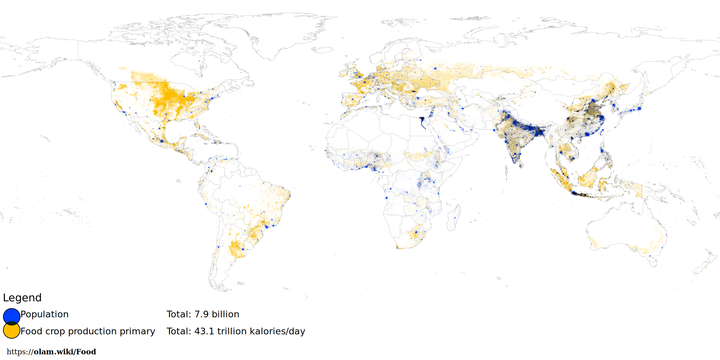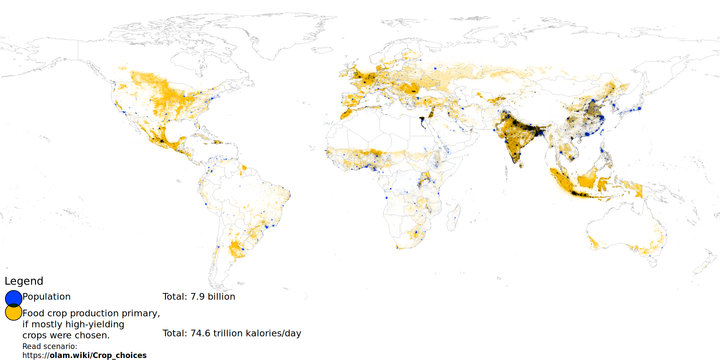Crop choices
One way to increase crop yields is to simply grow different crops.
Which crops get the highest yields? The answer is different in every region of the world. See this chart for all crops and all countries. Note: the page is quite big and may be slow to load.
Scenario overview
Let's explore a hypothetical scenario in which every country grows mainly its highest-yielding crops.
For each country:
- Each crop is given an amount of land proportional to the square of its yield score.
- The yield score is based on both calories and protein (human-edible only).
- Weighting: 2000 calories is equivalent to 60 grams of protein.
- Total amount of farmland (all crops combined) is the same as the status quo.
This scenario is generated by Code:food1.sql, which uses data from FAO (crop production/yields) and USDA (nutrition data).
Some key findings
- Globally, total crop yields (calories) would be almost doubled.
- In Africa, total crop yields (calories) would be tripled.
- The food supply would be more nutritionally complete. (...)When comparing the nutritional content per 2200 kalories:
- The status quo does not meet the daily recommendations for potassium, calcium, vitamin A, vitamin D, vitamin E, vitamin K, vitamin B5 (pantothenate) and vitamin B12.
- The new scenario would meet the daily requirements for all nutrients except vitamin D (normal for food in general) and vitamin B12 (normal for unfermented plant-based foods).
See section below for nutrition calculator links. - There would be far more fruits & vegetables (which vary widely by region).
(...)( So many, in fact, that they provide the bulk of calories & protein in the diet. It's not possible for a human to eat this many fruits & vegetables in their raw form. But they could be transformed into juices, concentrates, or even flours to be used in baked goods. Food ingredients would certainly look a lot different in this scenario. ) - However, some food choices are very questionable - such as ridiculously large amounts of garlic & chili peppers.
(...)( We're talking a whole pound of garlic+chilis per person per day. The sheer volume of this provides a significant amount of protein & calories in the diet. But for this to actually work in real life, there would probably have to be some kind of processing to remove most of the pungency (capsaicin, allicin, etc) because otherwise it would just be too much for anyone to handle. In a way, this would be similar to how today's food supply is based on grains that need to be cooked to destroy antinutrients. Garlic & chili probably get high yields because they're too pungent for most pests to eat. )
Maps - food crop production:
For a detailed breakdown by country, see this page.
Nutrition calculator links
The links below show the crops as foods in the nutrition calculator, as food per day per capita.
| World: | before | after | |
| Africa: | before | after | |
| Asia: | before | after | |
| Europe: | before | after | |
| North America: | before | after | |
| Oceania: | before | after | |
| South America: | before | after |
Note:
- This is primary production, which is significantly higher than what people actually eat.
- Not all foods can fit in the nutrition calculator, so the totals appear slightly less than the actual totals.
- The bar graphs overflow a lot. To make it easier to visually compare nutrients, try increasing the "Time Scale" to several days.
Using the crop choices to prevent deforestation
Improving crop yields can allow us to:
- grow more food from the same amount of land
(...)( This is the hypothetical scenario above, which was chosen only for simplicity sake. ) - grow the same amount of food using less land
- something in-between: Using a bit less land and also producing a bit more food.
Which one is best? Depends on whether food is currently abundant or scarce.
The "in between" is probably best for the world, overall - because:
- Even modest increases in food supply would be enough to end hunger, and
- Even modest decreases in land usage would be enough to end deforestation.
Economics
Labor & costs
The scenario involves a lot of fruits & vegetables which are currently more expensive (per calorie) than grains. If the costs have anything to do with farm labor, then we're looking at a scenario that would require a lot more people to work in agriculture. Then again, maybe not - perhaps the high prices of fruits/vegetables have more to do with grocery stores keeping them fresh. Consider how some countries can make sugar cheaply from sugar beets (a root vegetable, in some sense). Perhaps we could make similarly cheap nonperishable products (but hopefully more nutritious than sugar!) from abundant produce.
Importance of imports & exports
In the scenario, some countries grow an extreme amount of certain foods (foods that wouldn't, on their own, make a balanced diet). But worldwide - and even continent-wide, the food supply is quite nutritionally balanced (see nutrition calculator links). In other words, countries would really have to trade with each other.
This would require more shipping as food would be less local. But still, overall carbon emissions would probably be lower, because of all the deforestation prevented (see above). Keep in mind that food transport is only a small percent of food's environmental footprint. And it could be smaller still if foods are processed locally and shipped in their more concentrated forms.
Africa
Of all the continents, Africa currently produces the least amount of food crop per capita. This is probably a significant cause of Africa's high hunger rates (although technically it doesn't have to be). In the crop-choices scenario imagined, Africa produces 3 times as much food (both in terms of calories and protein). This is achieved by reallocating farmland: less land for grains, more land for sugarcane, chilis, bananas, potatoes, and garlic.
- Interpretation 1: Africa would benefit from growing more of these high-productivity crops instead of grains. Perhaps there's a historical reason for growing grains - maybe European colonialists thought it was a good idea because grains get high yields in Europe. In that sense, if Africa switched to the other (more productive) crops, it would be a form of decolonization.
- Interpretation 2: Sugarcane gets higher yields only because corporations invest more money & fertilizer into growing it. First-world countries want sugar, and their spending power makes it happen (highly-valued currency). The same first-world system doesn't care about Africa's grains, because grains can be grown "at home". So in Africa, grains get regarded as a "peasant crop", and the people who grow them are the poorest farmers and can't afford fertilizer. If it weren't for all this, perhaps grains would yield just as many calories as sugarcane.
- Interpretation 3: None of this really matters, because the whole crop-choices scenario is too hypothetical, and involves people eating an unrealistically high amount of chili peppers and garlic.
These interpretations are opposed to each other. The current dataset can't tell us which one (if any) is true. If you have some clues, join the discussion.
More considerations
Monoculture vs polyculture
Be careful not to interperet these results as "This one crop is the best, let's just grow that and nothing else!" It could be that some crops depend on each other for their high yields. I recommend growing a mix of top crops, and especially include legumes for nitrogen fixing.
Local variation
If a country is geographically big enough, different parts probably have different top-yielding crops (due to different soil/climate/etc). The current dataset doesn't have any info on this - crop yields are only a country-level average.
Social, economic, and technological factors
We can't prove that the top-yielding crop is always better-suited for the local region. In some cases, perhaps there are just more resources invested into it, such as fertilizer. In which case, some currently-less-productive crops could be just as good if given a chance. The current dataset has no info on this.
See also
- Food - the main page which includes other possible ways to improve the global food supply.

